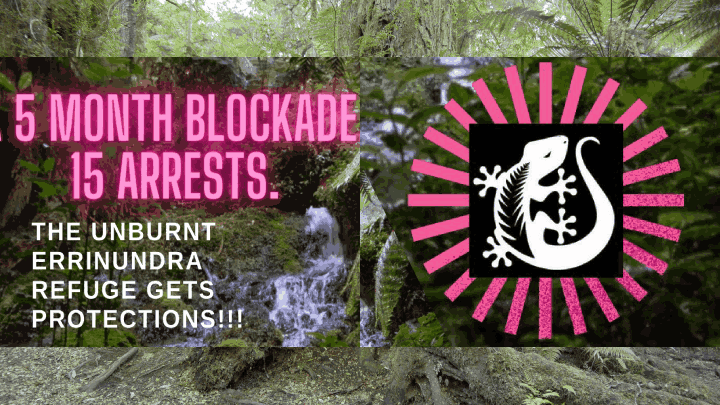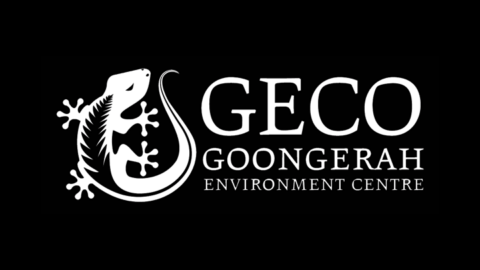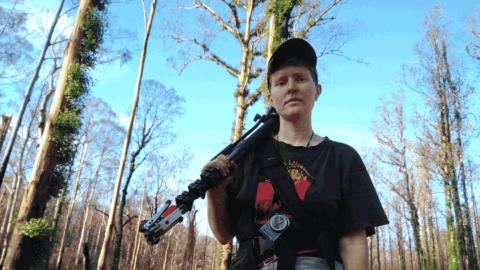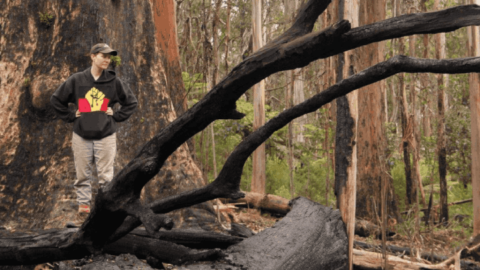
In the aftermath of the 2019-20 Black Summer bushfires, which saw two-thirds of protected East Gippsland forest burnt to the ground, the Andrews government immediately determined to greenlight the ongoing logging of the region without making any accommodation for loss.
Needless to say, local environment groups, such as the Goongerah Environment Centre (GECO) were outraged. Not only had they just suffered through one of the major flashpoints of the wildfires, but the remaining pockets of forests that survived were now under the direct threat of logging.

In response, GECO launched its Defend Errinundra blockade in early 2021. It lasted five months, until Environment East Gippsland successfully had the Supreme Court place an injunction on immediate logging in two Errinundra areas in May 2021, which was a process that was then ongoingly repeated.
The push to conserve the areas resulted in the Department of Environment, Land, Water and Planning conducting a threatened species risk assessment, which last week saw it announced that 29 Special Protection Zones, covering 8,740 hectares, have now been created in Errinundra.
Stamping out protest
This outcome is a major victory for GECO and the other groups involved in saving the pockets of East Gippsland forest that weren’t devasted by the fires. But it’s certainly not the end of the campaign, as state-owned VicForests is continuing to fell remaining areas of dwindling natural habitat.
And the Labor state government has recently established a new anti-protest regime that specifically targets nonviolent direct actions that environment organisations, like the Goongerah Environment Centre, have carried out in the past with great success.
Passed on 4 August, the Sustainable Forests Timber Amendment (Timber Harvesting Safety Zones) Bill 2022 has created draconian penalties that apply to actions aimed at preventing logging, in the same way the NSW government has attempted to deter climate protests via extreme penalties.
Then Victorian regional development minister Mary-Ann Thomas said in the bill’s statement of compatibility that she considers locking up nonviolent activists for 12 months to be in line with international human rights law and these laws protect freedom of movement and property.
Unifying the movement
This week saw First Nations peoples, unions, climate groups, students, and scientists gather before the Sydney courts in support of climate defender Violet Coco, and the rally saw the various groups unite as one voice against the imposition of the Perrottet protest regime and for action on climate.
And according to GECO campaigner Tuffy Morwitzer, the exact same thing has happened down in Victoria in response to the Andrews government regime: rather than have a chilling effect on protest, the laws have served to galvanise a much broader movement united against logging.
Sydney Criminal Lawyers spoke to Goongerah Environment Centre’s Tuffy Morwitzer about the Defend Errinundra victory, the details of the new anti-protest laws in Victoria, and what GECO now has in its sights following the success of its 2021 blockade.

Goongerah Environment Centre (GECO) campaigner Tuffy Morwitzer
Goongerah Environment Centre announced that its 2021 Defend Errinundra campaign has been successful in securing 29 new Special Protection Zones.
Tuffy, how did GECO’s campaign result in the designations?
The role of blockading is to prevent the immediate and irreversible harm to the environment. But it also buys time for the movement to be able to mobilise and mount political pressure.
GECO has a strong history of blockading. We ran the longest forest blockade in Australian history in Goolengook, which went for 5 years and had over 500 arrests associated with it.
So, we’re really supportive of this type of community action.
With Defend Errinundra, there were hundreds of people that came through and a really important part of that was played by Traditional Owners, the Bidawal people, as well as a broader engagement with Traditional Owners around this really important unburnt refuge.
All of these factors combined created a huge amount of political pressure. So, when the injunction came through, it gave the movement a bit of reprieve and it allowed us to refocus in support of the court case. It allowed us time to gather the data for the case.
Traditional Owners were a big part of this political pressure, as was the importance of the area that was highlighted in another significant case, where both Greater Glider experts from the defence and the prosecution said that no logging should be happening in East Gippsland, especially in the Errinundra area.
This was because of its biodiversity significance in being a place of higher elevation and in having significant areas of old growth forest, as well as 31 percent of listed species. So, it’s a really important climate refuge.
The campaign created the political pressure so that when it did come time to apply the protections it was politically hostile for them not to protect these areas up near Errinundra.
Fifteen forest defenders were charged over the five month blockade period. What were they charged in relation to? And what happened to them as a result?
They were charged with entering a timber harvesting zone, obstructing timber harvesting and failing to comply with a direction.
Usually, people were charged with a number of those offences and roughly, they carry about $600 each.
So, it was just fines. They were paying off fines.
Following a pickup in nonviolent climate action in Sydney earlier this year, the Perrottet government established a new anti-protest regime, which involves draconian penalties for those participating in such actions.
The Andrews government passed similar laws in August, targeting people staging protests like the one GECO held in Errinundra last year.
What do these new laws entail?
The new laws involve searching vehicles, confiscating personal belongings and the ability to ban people on suspicion of an offence. The length of timing for a ban varies, but the minimum is 28 days.
They expanded the description of a prohibited item to include a PVC or metal pipe, which is used for locking onto machinery.
If someone is found using one of those prohibited items to hinder, obstruct or interfere with logging, the penalties increase to up to a $21,000 fine or 12 months gaol time.
So, how are environmental groups in Victoria taking the imposition of these laws?
These laws were designed to pit environmentalists against workers. And when they were introduced, we had unions, as well as Traditional Owners, speaking out against them.
So, in terms of their social licence in vilifying environmentalists and pitting us against workers, the government did not win that battle.
What they did instead was to give us a gift to coalition build amongst these groups and to build that really strong broad-based movement to make these laws unworkable.
To be honest, that’s not a bad thing.
It is frustrating that the values of the environment and the value of people taking community action to protect these places during a climate crisis is not being respected and acknowledged in the way that it needs to be.
I also want to mention that when these laws were introduced Lidia Thorpe, Gunnai Gunditjmara Traditional Owner and Greens Senator, made it clear that these laws will not stop her exercising her sovereign right to defend her Country.
She is not alone on that. There are other Traditional Owners in East Gippsland that also have this specific position.
So, absolutely, we would be standing with those Traditional Owners against these laws, as well as opposing them as part of a broad-based movement.

Tuffy surveys an area of forest devastated by the Black Summer bushfires
The East Gippsland forests and communities were devastated by the 2019-20 Black Summer bushfires. How is the region faring three years after this disaster?
The recovery for both the bush and the communities is extremely varied.
In Goongerah, where our environment centre is based, we had eleven houses that burnt down and only one is in the progress of being rebuilt. However, in high tourist areas, such as Buchan and Mallacoota, investment has been a lot higher.
In terms of the forest, as a result of those initial injunctions of our blockades, logging moved more squarely into fire affected forest, which had very weak proscriptions, so Cann Rivers has been almost entirely cleared.
Logging progressed in other unburnt refuges that didn’t have the same initial defence that the Errinundra had.
So, there has been compromise. We did lose old growth and threatened species habitat in those areas.
Parts of the forest are recovering. The bits that they are logging are the forests that have the most potential to recover. They are usually only very mildly burnt.
So, these are very important channels of connectivity that allow species to migrate within a climate crisis, so we must preserve these areas.
And there are other parts of the forest that did suffer quite badly. East Gippsland had a big density of wet old growth forest, the biggest stretch in Victoria. Wet old growth forest doesn’t recover well from fire.
Having experienced the devastation of those fires, how do you account for entities like the Andrews government attempting to get back to logging immediately in the wake of the fires?
The community in Goongerah was completely shocked. We thought that after the worst bushfires in living memory in East Gippsland, which ripped through 81 percent of the forested area, that this was surely the end of this industry, which has never been sustainable.
But literally, in March 2020, when the embers were still cooling, the state government in conjunction with the federal government rolled over the Regional Forest Agreements, which commit to the continuation of logging.
It was kind of unfathomable that they did that. And it’s taken them three years to give protection to these critical unburnt refuges, which may well be the only places where some species survive because of the higher elevation and complexity of the ecosystems there.
And how do you consider government inaction on climate and its attempts to downplay the crisis?
The Andrews government commitment to climate change has seen some good steps in that direction, especially recently, but it’s still committing to logging the most carbon dense forest in the world, as well as opening up additional coal and gas projects.
That’s completely at odds with a progressive climate agenda.
And lastly, Tuffy, having secured the Errinundra victory, what does GECO have next in its sights? And how do consider the protest laws may impact this?
The Special Protection Zones prohibit logging but don’t provide permanent protection. So, we need all unburnt refuges to be considered high concentration value areas and be given permanent ongoing protection.
That is one piece of ongoing work. The other is we need to end logging immediately. The Victorian government committed to ending logging by 2030, then the Black Summer bushfires happened.
There has been no recalibration. We’ve seen the industry continually given a free pass to logging these critical areas. So, we need to listen to the science, and we need to end logging immediately.
In terms of the protest laws, as I said before, they give us a really good opportunity to coalition build across unions, with climate organisations and with Traditional Owners.
They also give us an opportunity to do that nationally because of the trend in anti-protest laws across the country, in NSW, Queensland and in Tassie.
We will definitely be working towards that very broad-based and almost national movement.
We will also be working on making sure there is greater investment in climate care outcomes both for the environment and for the people in the region. So, looking at what those green jobs look like for the environment and how we can make them work.
